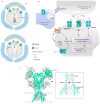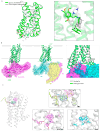Exploring Novel Antidepressants Targeting G Protein-Coupled Receptors and Key Membrane Receptors Based on Molecular Structures
- PMID: 38474476
- PMCID: PMC10934989
- DOI: 10.3390/molecules29050964
Exploring Novel Antidepressants Targeting G Protein-Coupled Receptors and Key Membrane Receptors Based on Molecular Structures
Abstract
Major Depressive Disorder (MDD) is a complex mental disorder that involves alterations in signal transmission across multiple scales and structural abnormalities. The development of effective antidepressants (ADs) has been hindered by the dominance of monoamine hypothesis, resulting in slow progress. Traditional ADs have undesirable traits like delayed onset of action, limited efficacy, and severe side effects. Recently, two categories of fast-acting antidepressant compounds have surfaced, dissociative anesthetics S-ketamine and its metabolites, as well as psychedelics such as lysergic acid diethylamide (LSD). This has led to structural research and drug development of the receptors that they target. This review provides breakthroughs and achievements in the structure of depression-related receptors and novel ADs based on these. Cryo-electron microscopy (cryo-EM) has enabled researchers to identify the structures of membrane receptors, including the N-methyl-D-aspartate receptor (NMDAR) and the 5-hydroxytryptamine 2A (5-HT2A) receptor. These high-resolution structures can be used for the development of novel ADs using virtual drug screening (VDS). Moreover, the unique antidepressant effects of 5-HT1A receptors in various brain regions, and the pivotal roles of the α-amino-3-hydroxy-5-methyl-4-isoxazolepropionic acid receptor (AMPAR) and tyrosine kinase receptor 2 (TrkB) in regulating synaptic plasticity, emphasize their potential as therapeutic targets. Using structural information, a series of highly selective ADs were designed based on the different role of receptors in MDD. These molecules have the favorable characteristics of rapid onset and low adverse drug reactions. This review offers researchers guidance and a methodological framework for the structure-based design of ADs.
Keywords: G protein-coupled receptors; cryo-electron microscopy; major depressive disorder; novel antidepressants; structure-based drug design; virtual drug screening.
Conflict of interest statement
The authors declare no conflicts of interest.
Figures






Similar articles
-
Other Antidepressants.Handb Exp Pharmacol. 2019;250:325-355. doi: 10.1007/164_2018_167. Handb Exp Pharmacol. 2019. PMID: 30194544
-
Storm on predictive brain: A neurocomputational account of ketamine antidepressant effect.Neurosci Biobehav Rev. 2023 Nov;154:105410. doi: 10.1016/j.neubiorev.2023.105410. Epub 2023 Oct 2. Neurosci Biobehav Rev. 2023. PMID: 37793581 Review.
-
Does increasing the ratio of AMPA-to-NMDA receptor mediated neurotransmission engender antidepressant action? Studies in the mouse forced swim and tail suspension tests.Neurosci Lett. 2013 Jun 24;546:6-10. doi: 10.1016/j.neulet.2013.04.045. Epub 2013 May 2. Neurosci Lett. 2013. PMID: 23643996
-
[Contribution of serotonin 5-HT2A receptor to antidepressant effect of serotonergic psychedelics].Nihon Yakurigaku Zasshi. 2023 May 1;158(3):229-232. doi: 10.1254/fpj.22141. Epub 2023 Mar 29. Nihon Yakurigaku Zasshi. 2023. PMID: 36990794 Review. Japanese.
-
A hypothesis of monoamine (5-HT) - Glutamate/GABA long neural circuit: Aiming for fast-onset antidepressant discovery.Pharmacol Ther. 2020 Apr;208:107494. doi: 10.1016/j.pharmthera.2020.107494. Epub 2020 Jan 25. Pharmacol Ther. 2020. PMID: 31991195 Review.
Cited by
-
1-(2,5-Dimethoxy-4-iodophenyl)-2-aminopropane (DOI): From an Obscure to Pivotal Member of the DOX Family of Serotonergic Psychedelic Agents - A Review.ACS Pharmacol Transl Sci. 2024 May 8;7(6):1722-1745. doi: 10.1021/acsptsci.4c00157. eCollection 2024 Jun 14. ACS Pharmacol Transl Sci. 2024. PMID: 38898956 Free PMC article. Review.
-
Investigating the causal relationship between inflammation and multiple types of hearing loss: a multi-omics approach combining Mendelian randomization and molecular docking.Front Neurol. 2024 Nov 28;15:1422241. doi: 10.3389/fneur.2024.1422241. eCollection 2024. Front Neurol. 2024. PMID: 39677857 Free PMC article.
-
Treatment-resistant depression: molecular mechanisms and management.Mol Biomed. 2024 Oct 17;5(1):43. doi: 10.1186/s43556-024-00205-y. Mol Biomed. 2024. PMID: 39414710 Free PMC article. Review.
References
-
- Fornaro M., Anastasia A., Novello S., Fusco A., Pariano R., De Berardis D., Solmi M., Veronese N., Stubbs B., Vieta E.J.P.r. The emergence of loss of efficacy during antidepressant drug treatment for major depressive disorder: An integrative review of evidence, mechanisms, and clinical implications. Pharmacol. Res. 2019;139:494–502. doi: 10.1016/j.phrs.2018.10.025. - DOI - PubMed
Publication types
MeSH terms
Substances
Grants and funding
- 82272348, 82270013, 81870016 and 82300016/National Natural Science Foundation of China
- 2021QN02Y720/High Talent Project of Guangdong Province
- 2023A1515030195, 2022A1515011223 and 2022A1515010525/Natural Science Foundation of Guangdong Province
- 2021KTSCX038/Characteristic Innovation Project of Universities in Guangdong Province
- 2022ZDZX 2021/Key Project of Universities in Guangdong Province
- 2022KCXTD010/Innovation Team Project of Universities in Guangdong Province
- 20211800905072, 20211800904782 and 20211800905542/Science and Technology Project of Dongguan
- 4SG22209G/Doctoral Initial Funding of Guangdong Medical University
- 4SG23290G, 4SG21229GDGFY01, 4SG22259G, 4SG23030G and 4SG23077G/Discipline Construction Project of Guangdong Medical University
- 4SG23143G, 4SG22098G and 1JG21027/In Vitro Diagnostics Industry College Project
- 2021SLABFN10/Open Research Fund of Songshan Lake Materials Laboratory
- 2022kfkt01/Open Research Fund for Key Laboratory of Tropical Disease Control Sun Yat-sen University, Ministry of Education
- GDMUD2022001/Youth Research Projects of Guangdong Medical University
LinkOut - more resources
Full Text Sources

